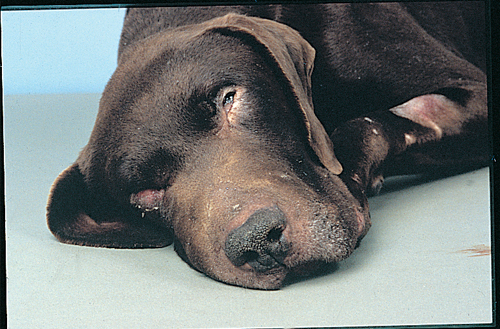Difference between revisions of "Small Animal Emergency and Critical Care Medicine Q&A 17"
| Line 19: | Line 19: | ||
In the above case the generalized signs should indicate that the disease is systemic. | In the above case the generalized signs should indicate that the disease is systemic. | ||
| − | |l1= | + | |l1=Anaphylaxis |
|q2=What pathologic mechanism(s) is involved? | |q2=What pathologic mechanism(s) is involved? | ||
|a2= | |a2= | ||
Immediate type I hypersensitivity reaction. | Immediate type I hypersensitivity reaction. | ||
| − | |l2= | + | |l2=Type I Hypersensitivity |
|q3=What is the treatment protocol? | |q3=What is the treatment protocol? | ||
|a3= | |a3= | ||
| Line 29: | Line 29: | ||
The patient is best hospitalized for 12–24 hours for observation for further delayed or protracted reactions. | The patient is best hospitalized for 12–24 hours for observation for further delayed or protracted reactions. | ||
| − | |l3= | + | |l3=Anaphylaxis#Treatment |
|q4=Which clinical signs would you expect if it were a cat? | |q4=Which clinical signs would you expect if it were a cat? | ||
|a4= | |a4= | ||
Early signs in cats are different from those in dogs. Extreme pruritus of the head and respiratory distress due to upper airway obstruction by laryngeal edema, bronchoconstriction and increased mucus production are common. | Early signs in cats are different from those in dogs. Extreme pruritus of the head and respiratory distress due to upper airway obstruction by laryngeal edema, bronchoconstriction and increased mucus production are common. | ||
| − | |l4= | + | |l4=Anaphylaxis |
</FlashCard> | </FlashCard> | ||
Revision as of 22:11, 10 October 2011
| This question was provided by Manson Publishing as part of the OVAL Project. See more Small Animal Emergency and Critical Care Medicine Q&A. |
On the morning of a beautiful summer day, a five-year-old, male German Pointer played unattended in the backyard garden. During the following 24 hours the right side of the dog’s face became swollen. The dog developed urticaria and became lethargic, unable to walk and vomited several times.
| Question | Answer | Article | |
| What is your presumptive diagnosis? | Angioedema or anaphylaxis, probably caused by an insect sting. Anaphylaxis can be ‘localized anaphylaxis’ (urticaria and angioedema) or ‘systemic anaphylaxis’ (generalized signs). In the above case the generalized signs should indicate that the disease is systemic. |
Link to Article | |
| What pathologic mechanism(s) is involved? | Immediate type I hypersensitivity reaction. |
Link to Article | |
| What is the treatment protocol? | The offending agent is removed if possible and supportive care given with antihistamines, corticosteroids and epinephrine as indicated. The patient is best hospitalized for 12–24 hours for observation for further delayed or protracted reactions. |
Link to Article | |
| Which clinical signs would you expect if it were a cat? | Early signs in cats are different from those in dogs. Extreme pruritus of the head and respiratory distress due to upper airway obstruction by laryngeal edema, bronchoconstriction and increased mucus production are common. |
[[Anaphylaxis |Link to Article]] | |
